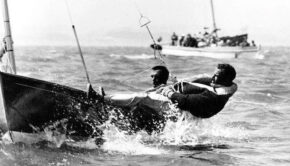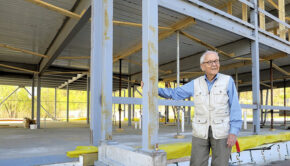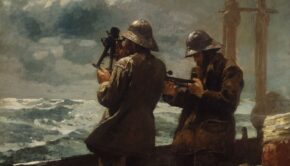Eight Bells – Henry “Hank” Strauss
Published on October 21st, 2013
 He was born on New York’s upper west side nearly 99 years ago; he was not a big man but he filled a huge space with his enormous intellect and heart to match.
He was born on New York’s upper west side nearly 99 years ago; he was not a big man but he filled a huge space with his enormous intellect and heart to match.
Racing and cruising sailor, adventurer, musician, artist, World War Two superhero, Academy Award nominated film maker, husband, father, grandfather and great grandfather – Hank Strauss had it all and did it all in his 98.75 years and when he died of lymphoma Saturday evening he left a host of friends and disciples who will find a gap in their lives that no one else can fill.
Isaac Henry Strauss was a member of Noroton Yacht Club, New York Yacht Club, the Cruising Club of America (He was Commodore of the CCA New York Station at the age of 90) and the Ischoda Yacht Club.
Predicting accurately that the U.S. would soon be in the war, Hank joined the Navy before Pearl Harbor and when the U.S. entered the war he was Quartermaster on the supply ship USS Pollux on the run between New York and Argentia, Newfoundland . Fighting a full gale in a pre-dawn blizzard on Feb. 19, 1942, the Pollux and the destroyer escorts USS Truxtun, and Wilkes, ran hard aground at the foot of a steep cliff in Chambers Cove near the villages of St. Lawrence and Lawn. The rudimentary navigation available at the time had let them down and they were 60 miles to the west of their destination.
(The story of this disaster in which 203 sailors died can be read in the brilliantly crafted book Standing Into Danger, by Newfoundland author Cassie Brown and originally published by Doubleday. It marked the greatest loss of life in U.S. Navy history outside of enemy action.)
With the Pollux pounding against the vertical cliff and taking on water, Henry Strauss realized that something had to be done quickly or the whole crew would be lost. There was a ledge of rock on the cliff a few feet above the surface. Crew members had been throwing a grappling hook to the ledge in an attempt to have it grab so someone could go climb across with a bigger line and set up a breaches buoy system to get the crew across. Finally the hook caught and seemed secure enough to do the job. They needed a volunteer fit enough to go hand over hand to the shore. Hank was that volunteer. Small, wiry and brave almost beyond reason he was also a college diving and swimming champion.
He went across the 100 foot space “like an acrobat” as one officer put it later. He got to the ledge and as he was trying to get a footing on the icy rocks a huge wave crashed against the cliff and dragged Hank into the icy caldron capped by thick oil and chunks of wreckage. He was under water for what seemed like an eternity and when he finally surfaced – freezing and losing consciousness – could not believe why he was not being pulled back to the ship. But his shipmates had difficulty getting him aboard because the safety line was covered with oil. Finally a big stoker wrapped the line around his waist and using himself as a windlass he rotated his body, aided by crew mates, and managed to get Hank up the vertical side of the violently heaving vessel. Suffering hypothermia, badly bruised and nearly blind from the oil, he was carried to the sick bay.
Half and hour later as the tide rose and the ship got closer to the cliff an officer got the idea that if they could extend a cargo boom out to port someone might be able to get to the ledge from the end of it. They could not find a volunteer on deck, but from the sick bay came Henry Strauss, ready to give it another try. Again his valor was thwarted as the boom could not be extended far enough and the motion at the end of it was appalling. They swung the boom and Hank back aboard.
The captain gave the order that anyone who wanted to try to save himself was free to do so and many jumped into the sea and tried to swim ashore. None of them made it, and they died of hypothermia and drowning. Their bulky kapok life vests floated up around their shoulders and they were left bobbing in the oil and debris with their arms above their heads – hundreds of them. As the Pollux was battered even closer to the ledge and beach four men were able to take the last lifeboat through the surf and climb up the rocks. But they were so cold and exhausted they were unable to be any help to the rest of the crew.
Back aboard the Pollux, with the ship grinding its way ever closer to the rocks, they they finally got a line to the ledge with ease and about 50 men, Hank among them, got onto the ice capped outcrop. As they huddled together the oily waves picked them off one or two at a time and dragged them into the sea.
With time running out they heard a voice above then shouting – “is anybody down there?” On top of the cliff were Newfoundland fishermen who had been called to action by two teenaged boys who had seen lights and heard the clanging and grinding of the ship on the rocks. Alerted by the youngsters, fishermen trudged through the thigh deep snow for two miles and lowered a long line down the vertical face and pulled what was left of the Pollux crew up one at a time. It took nearly three hours to get them all up and they lit fires and tried to camp on the level ground until dawn. Several of them froze to death that awful night, but before sunrise the villagers had brought sleds and horses and took the sailors to their homes where they were fed and warmed and literally brought back to life.
(In 2011 Hank Strauss gave a generous grant to the towns of Lawn and St. Lawrence, specifying that the money be used to buy equipment for their grade schools. Months before he died he got a Skype call from Newfoundland and found himself facing scores of children on their computers thanking him and questioning him about that fateful night 70 years before.)
Returning to New York after the Newfoundland disaster Hank was given a commission and sent to sub chaser school in Florida. He served in the Caribbean for a short time and then was sent off to the South Pacific theater in the tiny wooden Sub Chaser 668. From time to time during this long voyage they would be visited by one or more destroyers, which traveled much faster but would drop by to check on SC668. They encountered a typhoon north of New Zealand and the sub chaser was heaving and rolling so badly that the crew was constantly afraid she would roll right over. Hank ripped the inclinometer off the bridge and threw it overboard so his men could not watch it. He took the helm himself during the worst of the storm and tried to steer like he would have in a small sailboat on a much smaller stage – surfing down the huge waves, but then turning to port or starboard before reaching the bottom of the trough, so they could slow down enough to be picked up by the next monster. They struggled into Auckland with the little ship badly damaged and “leaking like a basket” as Hank put it later. When Henry Strauss walked into a harbor-side bar in Auckland he was spotted by the captain of one of the destroyers, who literally dropped his glass on the floor, having been certain that SC688 could not possibly have survived the typhoon.
After weeks of repair and re-hab SC688 proceeded north west to the battle zone. Hank and his men were off the beach at Guadalcanal when the Marines re-took the island from the Japanese. His sub chaser shot down three enemy aircraft during the campaign. At one point Hank had a parachuting Japanese airman, in his sights but couldn‘t pull the trigger. The parachutist was out of action anyway.
Called back to Washington for special duty, which was not revealed, he was then sent back to the Pacific just before war’s end and with a team of assistants, was assigned to chart the Solomon Islands. The Navy had been using charts made by Captain James Cook in the 1760s, and by using modern (at that time) instruments Henry Strauss, now an unlikely cartographer, was able to make far more accurate charts of the many islands and reefs.
During his many battles — perhaps the most famous in Tulagi – with U.S. forces facing more than 100 Japanese zeros – Hank made a discovery that changed his life. According to Navy regs, new recruits were trained to load the 3 mm guns by reading the manual, then practicing. With that training so essential to everybody’s life, Hank decided to start by telling the recruits how many bullets a zero could fire in the time it took to load the gun, then gave them the manual to read, then had them practice. Loading time was cut in half. The difference was the attitude created, the motivation, along with the training.
Towards the end of the war, Henry offered his discovery about attitudes and training to the Navy’s training division at the US Bureau of Ships. After many months, they had the wisdom to bring him back to Washington, to make training films applying his ideas.
Following the war Hank took his theories on training and communication and became a pioneer in the fledgling corporate communications/human relations business in NYC. Among his first management training films was THE INNER MAN STEPS OUT, made for GE and used by Ford Motors as well, for its unique and effective approach to human relations. Over the years clients for his firm Henry Strauss Communications Inc, on West 53rd St included giants like AT&T, IBM, Gulf, Dupont and Pan American Airways.
With the contract from Pan American he traveled to many countries to which Pan Am was setting up air service. He made films in Britain, Russia, Japan and Tahiti. For the Russian assignment he went alone with his small Bolex camera, just after Gary Powers had been shot down in the U-2 incident. He was getting along well until being arrested and held in a southern city on suspicion of spying. When he explained his mission the local police tried to check his story and, after four phone calls, ended up talking to the foreign relations office at the Kremlin. “Oh that’s only Strauss” they told the police, “Let him go, he’s our friend.”
He also worked in educational and motivational films and won an Academy Award nomination for a film on Art for the National Endowment on the Arts, called “Art Is”. His business was so successful he planned to retire at the age of 50, but he didn’t quite make it and set his movie camera aside at age 51.
During the Great Depression of the 30s Hank struggled to find employment. For a while he and two friends formed a string trio (Hank played the banjo) and performed at some of the grungier fleshpots of Manhattan. They had a deal with club owners – as soon as the first punch was thrown in the audience the trio was allowed to leave. They had many early nights.
In the late 30s he climbed aboard his old Indian motorcycle and headed across the country, feeling that if he couldn’t get meaningful work he would learn as much as he could about the U.S.A. When going through Texas with a New York friend on the back seat, the carburetor failed and Hank decided to take it on foot to the next town for repair, leaving his friend to guard the bike. When he got back the bike was there, but his friend was not. He reported his buddy missing to the local police and to the man’s family in New York, but no one had heard from him. The police held Hank on suspicion of murder. Two days later the missing man called the police from his home and Hank went on his merry way. His “friend” had become bored with his bouncy transport and had hitched hiked home without leaving a message. Getting by with very little cash, hank also was held for vagrancy near Seattle until authorities could convince themselves that the obviously resourceful little New Yorker could in fact look after himself.
From there on on he spent an incredibly active life of travel and adventure. He chartered the 70-foot yawl Stormvogel and cruised around New Guinea.
In the years of the IOR Hank owned a 40-foot S&S sloop with three partners. They raced often and well in all the East Coat events, including the Bermuda race, a Trans-Atlantic race in and the Fastnet. He owned a property on the Caribbean island of Grenada and cruised his 41 foot Morgan back and forth fall and spring for many years.
Hank was married in 1940 to Joan Strauss (the same name but no relation) and they took their honeymoon on a 20-foot centerboard sloop, not unlike a Lightning. Jo died two years ago in their waterfront Darien, Ct. home and a year later Hank moved to Mill Valley, California. He leaves two daughters, Jan Raymond of Darien, Ct. and Terry Strauss-White of Mill Valley. Granddaughter Sasha White lives in NYC. Grandson Joshua Raymond lives in Washington, DC and Luke Raymond in New York City and Darien. They are both fine helmsmen. Great grandchildren are twins Henry and Lucy, daughters of Joshua, and Rhys, son of Luke.
When Luke and Joshua had their final visit with Hank a week ago, their grandfather’s last words to them were “keep it interesting.” Amen Henry. – Bruce Kirby, October 21, 2013








 We’ll keep your information safe.
We’ll keep your information safe.